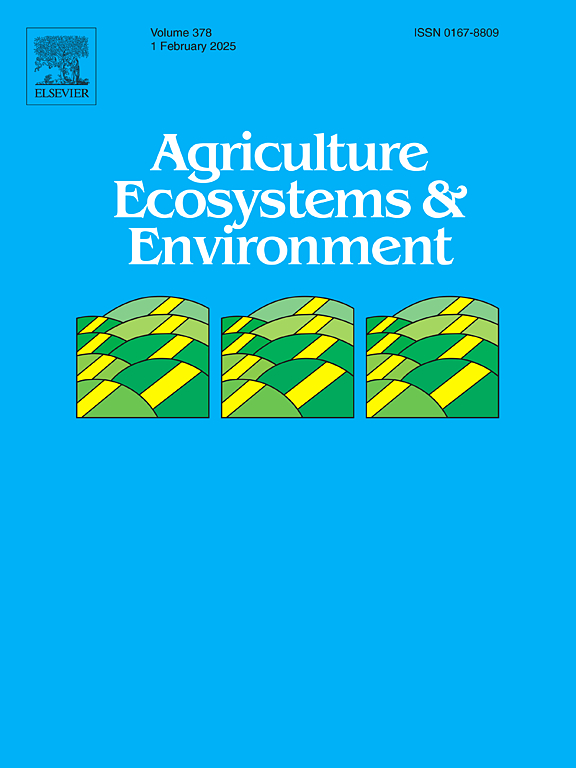Nitrous oxide emissions from maize following grass-clover: Treatment of plant cover and manure with 3,4-dipyrazol phosphate (DMPP) as mitigation strategy
IF 6.4
1区 农林科学
Q1 AGRICULTURE, MULTIDISCIPLINARY
引用次数: 0
Abstract
Animal agriculture is a major contributor to greenhouse gas emissions, with nitrous oxide (N2O) playing a critical role. In dairy farming, grass-clover (GC) is widely used in crop rotations and often preceding maize, but the period between GC incorporation and maize N uptake has a high risk for environmental losses, including N2O emissions. This study investigated if a nitrification inhibitor, DMPP, can reduce spring N2O emissions from maize after GC on sandy soil with or without cattle slurry (CS) as supplementary N. The inhibitor was applied to GC before incorporation, together with CS, or both. Emissions of N2O and concentrations of N2O at 5, 10, 20 and 30 cm depth were monitored during spring in two years. The highest cumulative emissions were observed in the unamended GC+CS treatment (5.1 and 4.2 kg N ha⁻¹ in 2022 and 2023, respectively). N2O emissions often occurred at < 60 % WFPS, showing that GC residues and liquid manure created anaerobic conditions sustaining emissions. DMPP application to GC did not significantly reduce N2O emissions, possibly due to NO₃⁻ derived from roots. Also, N2O accumulation at 20–30 cm was enhanced by CS despite injection to 8 cm depth, suggesting downward transport of NO₃⁻. When applied with cattle slurry, DMPP effectively reduced emissions by an average 71 %, with some treatments even exhibiting net negative emissions. These findings highlight the complexity of soil N dynamics after termination of GC pastures and the importance of management strategies to mitigate this source of N2O emissions in dairy farming systems.
玉米继草三叶草后产生的氧化亚氮排放:用3,4-二吡唑磷酸盐(DMPP)作为缓解策略处理植物覆盖物和粪肥
畜牧业是温室气体排放的主要来源,其中一氧化二氮(N2O)起着关键作用。在奶牛养殖中,草-三叶草(GC)被广泛用于作物轮作,通常在玉米之前,但在种植草-三叶草和玉米氮吸收之间的这段时间有很高的环境损失风险,包括N2O排放。本研究考察了一种硝化抑制剂DMPP是否能减少玉米在沙土中添加或不添加牛浆(CS)作为补充氮后GC后春季N2O的排放。该抑制剂在添加前与CS一起或两者同时施用于GC。在2年的春季监测了5、10、20和30 cm深度的N2O排放量和N2O浓度。在未修改的GC+CS处理中观察到最高的累积排放量(分别在2022年和2023年为5.1和4.2 kg N ha⁻¹)。N2O排放通常发生在<; 60 % WFPS,表明GC残留物和液体粪便创造了维持排放的厌氧条件。DMPP应用于GC并没有显著减少N2O的排放,可能是由于NO₃来源于根。此外,即使注射到8 cm深度,CS也能增强20-30 cm的N2O积累,这表明NO₃⁻。当与牛浆一起使用时,DMPP平均有效地减少了71 %的排放量,有些处理甚至表现出净负排放。这些发现强调了GC牧场终止后土壤N动态的复杂性,以及在奶牛养殖系统中减少N2O排放源的管理策略的重要性。
本文章由计算机程序翻译,如有差异,请以英文原文为准。
求助全文
约1分钟内获得全文
求助全文
来源期刊

Agriculture, Ecosystems & Environment
环境科学-环境科学
CiteScore
11.70
自引率
9.10%
发文量
392
审稿时长
26 days
期刊介绍:
Agriculture, Ecosystems and Environment publishes scientific articles dealing with the interface between agroecosystems and the natural environment, specifically how agriculture influences the environment and how changes in that environment impact agroecosystems. Preference is given to papers from experimental and observational research at the field, system or landscape level, from studies that enhance our understanding of processes using data-based biophysical modelling, and papers that bridge scientific disciplines and integrate knowledge. All papers should be placed in an international or wide comparative context.
 求助内容:
求助内容: 应助结果提醒方式:
应助结果提醒方式:


